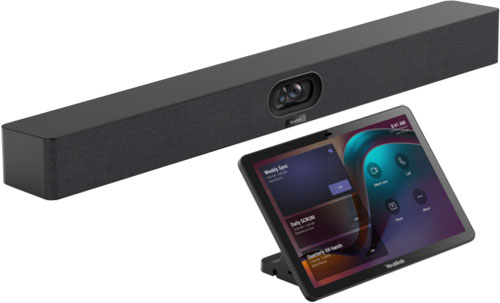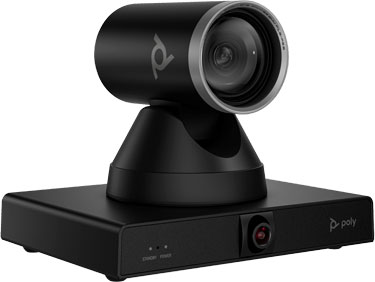Here’s a frequently-asked-question that our video conferencing experts get: Can you use a projector for video conferencing?
Your business might already have a projector and screen set up in the conference room that you use to display content during meeting like charts with the line going up to the right (hopefully). Can you retrofit this projector for video conferencing?
In this blog, we weigh the benefits of using a projector vs using a TV in a professional video conferencing space.

Projectors for Video Conferencing
Let’s be blunt: We don’t think projectors work well for video conferencing. The big problem is the video conferencing camera. Where do you put it? How do you light the room? We’ll take each of these in turn.
Positioning a video camera around a projector screen poses some pretty difficult questions. If you put it above the screen, you’re going to get a top-down view of people that’s more like a computer RPG than a video call. If you put it below the screen, you’re going to get an unflattering look up the participants’ noses. A single video camera to the side of the projector screen will make the eyelines completely off.
You could use a dual-camera set-up with cameras to either side of the screen. That would work. But it also leads into the next big problem with using a projector for video conferencing: light.
Most projectors aren’t as bright as TVs — not even close, really. They’re meant to be used in darkened rooms. But cameras need good light to get good video. Otherwise, you’re going to get heavily processed, pixelated video. People’s faces will be in shadows.
And the camera, which will be facing the projector, will have to deal with the bright light shining behind the participants. Even the best back-light compensation will struggle with such a high contrast challenge.
You can paint the projector screen on a wall. People have asked us if you could mount the camera in the middle of a wall projection screen. While this would make the eyelines the most natural of any possible arrangement, it’s a disaster in terms of light. The camera will need to directly face the projector. (And this ignores the fact that you’d have a camera in the middle of your screen, which is… undesirable.)
A video conferencing camera is essential for video conferencing — obviously. And it’s an insoluble problem for using a projector in the conference room.
Thankfully, TVs have gotten really affordable. A quick search of a popular technology store turned up multiple 75-inch 4K Ultra HD TVs for less than $500. (Put yourself back a couple of decades and imagine telling younger-you that: 75-inch TV. Less than $500.)
Besides extending the lifetime of existing equipment, the primary benefit of a projector is its size. Projection screens can still be larger than TVs, but 85-inch-plus TVs are now quite common and quite affordable. It’s pretty amazing that TVs have gotten almost as big as the projector screens you’d use in a meeting room, isn’t it?

Benefits of TVs for Video Conferencing
TVs offer many advantages for video conferencing when compared with projectors.
Positioning the camera is simple: You put it centered on top of a display. The camera angle and eyelines will be more familiar and naturalistic.
There’s also an alternative solution: a 360° camera that’s positioned in the middle of the conference room like the Yealink MVC S60 Video Conferencing Kit, which uses the SmartVision 60 360° camera.
You can use TVs in brighter rooms than projectors, so your video quality will be improved. The TV won’t shine into the camera, so you don’t need to worry about extreme light contrasts.
A big advantage TVs offer is the possibility for dual display or even triple display arrangements, which are impossible, or at least clumsy and expensive, with projectors.
TVs are simple to connect to the video bar or computer you’re using for video conferencing: In almost every case, you just need to connect a single HDMI cable from video conferencing device to TV.
They’re also simpler to operate. You don’t need to worry about angling the projector screen correctly, adjusting the zoom length, or tweaking distortion compensation due to the angle at which the projector is shining. You never have to learn what the term “short throw projector” means or what “throw ratio” is. You can throw out that worry!
You have a wider range of professional-grade options with TVs than with projectors. 4K Ultra HD displays are plentiful and available everywhere.
TVs are also more versatile than projectors. You can install one on an AV cart to move it from meeting room to meeting room as needed. (We cover AV carts in just a bit.)

Using Both a TV and a Projector
You could also establish a multi-use conferencing room with projector and TV. If this interests you, we recommend this arrangement:
The projector screen is installed on or in the ceiling. It can be lowered down from the ceiling. The screen is installed far enough away from the back wall that there’s space for the TV, camera, and any other video conferencing gear. If you want to use the projector, lower the screen. If you want to use the TV, raise the screen out of the way.
This arrangement obviously isn’t geared towards cost-saving. But if you want the benefits of both projectors and TVs, it’s the best arrangement we know of.

TVs at IP Phone Warehouse
At IP Phone Warehouse, we don’t sell TVs besides touchscreen TVs for video conferencing and digital whiteboarding like Yealink MeetingBoard 65.
We do, however, sell AV Carts, Stands, Wall Mounts, and Credenzas that provide multiple installation options for your conference room TV.
AV carts let you move the video conferencing display between spaces, which can help you maximize your return-on-investment. Here’s the equation: You can use one TV in more than one room. There are AV cart options with integrated storage to protect your video conferencing gear, adjustable height stands to fit varied locations, and more.
Stands and wall mounts are exactly what you think they’d be. We sell TV stands with small footprints and rugged, all-steel design for a stable, space-conscious, free-standing TV. The wall mounts we sell include single display or dual display models with platforms for holding the camera above the TV.
Credenzas are elegant furniture for classy, professional video conferencing rooms. We offer video conferencing credenzas with rock steady TV mounts, space for a tech equipment rack below the display (or even a mini-fridge), and more.

